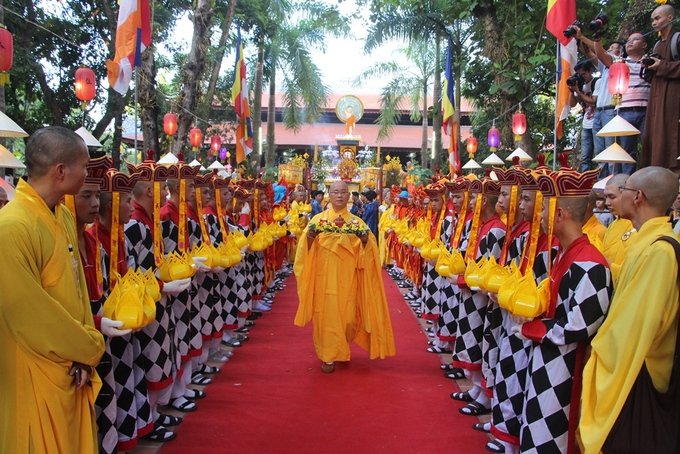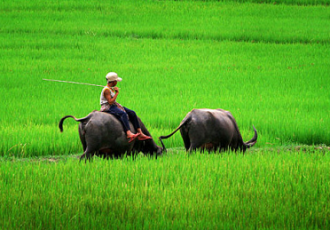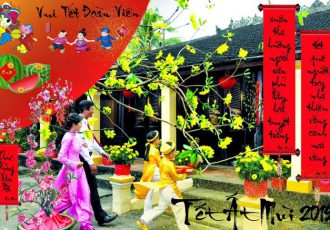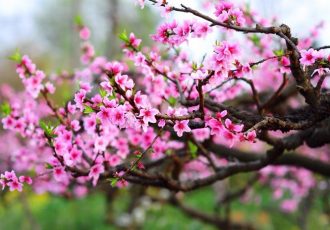Cultural activities in general, and the village festival in Vietnam in particular, are the best known, most significant and most cherished of all for people living in the countryside. Every year, at the return of spring and autumn, country people have the opportunity to rest after the fatigue of the harvest. Traditional festivals are organised everywhere to celebrate these occasions.
The farmers work all year round, under the sun and the rain. They have only two opportunities to rest, during the first two months of the year and during the month of August, i.e. after the transplanting of rice in the fifth lunar month and the tenth lunar month. During these periods, they wait for the rice harvest and the harvest of dry land food crops.

Spring and autumn thus become the two seasons for village festivals. But the most numerous are the spring festivals. Villages in Vietnam compete with each other in organising their festivals. Some start as soon as spring arrives. Others organise them a little later.
The importance of the village festival:
The main purpose of festivals is not to entertain the people. The Vietnamese village festival is primarily intended to express the respect and gratitude of the villagers towards their tutelary genies, the spirits who protect the villages. According to popular belief, the tutelary genie remains in the communal house, witnessing the life of the villagers, protector and defender of all, he shares their daily life and keeps in his memory all the memories of the village.
This occasion allows the villagers to get to know each other. Vietnam is an agricultural country. The peasants are busy almost all year round with field work, so they rarely have the opportunity to meet and chat…. In addition, there is little contact between the municipal administration and the people of the village. The commune councillors are sometimes misunderstood by the villagers. Village festivals in Vietnam are therefore a good opportunity for leaders and villagers to meet and understand each other better.
It is the right time for villagers who are not familiar with the traditional rites to discover them, or who do not often participate in the festivals because of their economic situation, to know their value. In this way, the beautiful traditions are preserved and valued.
In this way, the beautiful traditions are preserved and valued
Many cultural activities are organised on this occasion, encouraging the participation of villagers.
Rice cooking competitions, weaving competitions, and baby-sitting competitions all take place at the same time. Is this not the encouragement of girls in domestic work? The cockfight, the contest for the most beautiful and largest pig, are intended to encourage breeding.
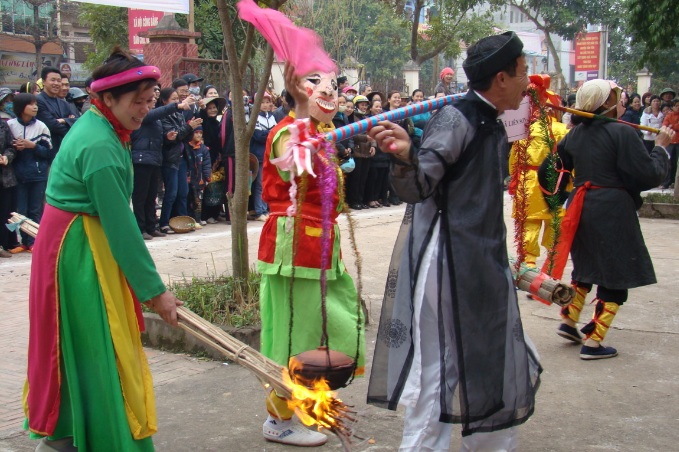
Wrestling, martial arts, and junk competitions aim to encourage young people in physical education for national defence.
The poetry competition encourages people to continue their studies. The staging of theatrical plays aims to recall either a part of the glory of a genius or the grandiose apogee of the Vietnamese people.
During these festivals, it is also an opportunity for young Vietnamese villagers to get to know each other, and to reveal their loves. Confucian idiology prevents, to some extent, young people from meeting each other whenever they want. They therefore wait for favourable opportunities to express their feelings. They are looked upon with a ‘benevolent eye’ by the respectable and venerable people of the village. During this occasion, some villages organise swinging games for two, followed by weddings, and the harmony between the nature of the beginning of spring and the joy of the people is noticeable.
Finally, on this occasion of village celebrations, copious meals are often organised in the community house, attended by almost all the villagers. Each family brings its share, often a sum of money which allows the village leaders to prepare meals with glutinous rice, pork, vegetables, fruit and alcohol. After eating, each family receives its share to take away. Therefore, every time the village holds the banquet, the villagers gladly contribute so that they can attend and receive their share of the meal.
These are the main purposes for which village festivals in Vietnam are organised. Apart from these reasons, there is another reason that is no less important to the villagers: Two neighbouring villages are rivals, over a dispute about territory illegally occupied by the other party, for example. At a village festival, the neighbouring village sends its representatives to express solidarity. This rare occasion allows the two rivals to forget their grudges, to sit down to negotiate and to strengthen their good neighbourly relations.
The Vietnamese organise their celebrations in spring and autumn because of the climate, because in spring it is warm, in autumn it is cool. In spring a new year begins. Autumn marks the return of a favourable season, after the rainy and stormy season.
The village festival usually has three main ritual phases:
- Celebration of worship ceremonies (te le)
- Entertainment games
- Feasting
La célébration des cérémonies de culte est une façon d’exprimer le respect, la reconnaissance des habitants du village envers leur génie tutélaire ou le fondateur de leur village.
The cleaning of statues (Moc Duc):
On the eve of the festival, in the communal house or at the time when the genie lives, the statues are cleaned first with clean water from the well or the river, using a red towel, and then with water-soaked in Garo (eagle wood) and seasoned with five ingredients (basil, among others)
The clothing of statues (Gia quan):
The statue of the hero is dressed in the clothes and hat that the king gave him and that he wore during his lifetime because of his merit to the country. If these clothes and hats no longer exist. They are replaced by paper clothes and hats. Once again, the village elders wash the face of the statue with five-ingredient water. The red cloth used to wash the statue must be divided into several pieces. The custom says that this cloth will bring luck to the one who wears it around his neck.
Organisation of the procession (Ruoc):
During the procession, the statue of the genie is carried or returned either from the temple to the community house or to a place of worship. The procession must be solemnly organised at the communal level. Only boys of 18 years or older are allowed to accompany the procession.
The ceremony begins with a string of firecrackers, then the two palanquins are brought out of the temple and displayed.
The procession then begins. At the head of the procession come two flags (Viet, Mao) which symbolise the power of the genies. Tiet is the flag of command that the king entrusts to the person he trusts. Mao is the feather-braided flag that symbolises the title granted by the king.
Then come five flags of five colours (ngu Hanh): blue, red, white, yellow and black, symbolising the five armies of the hero. Red represents fire, yellow represents soil, blue represents wood, white represents metal and black represents water.
Some Vietnamese villages use four flags, instead of five. The four flags represent four orientations: Blue means East, red means South, white means West, and green means North. After these five flags come four others representing four sacred animals (tu linh). On each flag is embroidered the image of an animal, the dragon, the unicorn, the tortoise or the phoenix.
The young boys, flag bearers, dress in the manner of the soldiers of the past. They wear a soldier’s hat on their head and a belt tied to one side.
After the flag, the big drum, symbol of the rallying to the battles and whose outline is lacquered with traditional gold and red, is carried by two people. Another strikes it with a golden stick, another boy carries a large parasol to shade the drum.
The large gong that always accompanies the drum is carried by two other men, while a third strike it, and a fourth carries the parasol
Next, there are two white and red wooden horses on a stretcher carriage, pulled by a man in the procession. Along the procession, we notice a troop of musicians, Dong van, who carry small tambourines with handles and gongs, followed by three people wearing hats” Dau), whose belts tied on one side each hold a sword.
After the Dongvan troop, it is the covered palanquin (Long Dinh), on which the five offerings (according to the Buddhist rites; water; incense; rice; candle; flower) and some vases with incense sticks have been put.
The other open palanquin, on which the hat and the clothes or the statue of the geniuses are placed, if necessary, is carried by eight people assisted by eight others, in case of replacement.
The procession is completed by the elders and officials of the village. All are in traditional costumes.
Sometimes a procession is co-organised by two or three villages because they have the same protective genie. In this case, the procession is often very long. The number of participants is greater. Each village has a covered palanquin, except for the “most important village” which has an open palanquin.
Distractions during the party
Swing
There are several models of swings: push-your-own swing (dua), pull-your-own swing, and swing in the form of a swing. The bamboo swing is usually made of 4-meter-long poles. The simplest swing is “dua”. It can be ridden by two people or alone. Usually, a girl and a boy climb up and swing, using their feet and backs to push themselves up and down.
Wrestling
The wrestlers are usually called Do Vat. This name is often explained by the fact that at one time the kings had very strong palanquin bearers called Do Luc Si, and by extension, the wrestlers were given their name.
On the occasion of festivals, wrestling competitions are organised, in which troops of wrestlers come to compete for the prizes awarded. The village displays the prizes in front of the town hall. Examples of prizes: first prize, three antique piastres, a turban, second prize, two piastres. Before the fight, the wrestlers address a prayer to the genie of the communal temple.
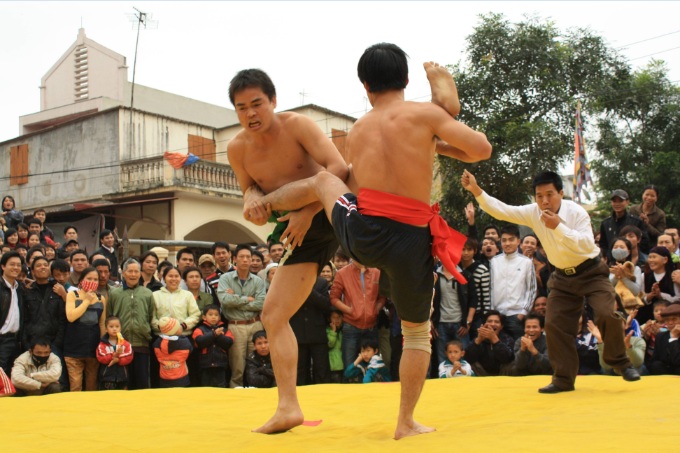
Bird fights
The birds used for fighting are large male nightingales (hoa mi). They are fed in cages of various shapes (round, square, hexagonal, octagonal) and beautifully lacquered. As food they are given millet (ke) mixed with egg yolk and, as the day of the fight approaches, they are given Korean ginseng water (nuoc sam cao li) to increase their strength. The birds fight in a special cage with a square door and a catwalk inside where the fight takes place.
When two birds are to fight, their cages are brought together and the cage of a female is placed between them. When both males have had a good look at the female, the cage is removed from the female. On the bridge, the two opponents fight with their beaks and legs. The fight is stopped if one of the birds is injured or if they run away.
The rules of the fight are as follows: For each beak strike of one bird on the other, the representative of the latter pays one coin, for each leg strike, the sum paid is five coins.
Fish fight
In Vietnam, the fighting fish is a special fish; its size is as big as a finger, its body is lightly striped with red and green, and its tail is long (ca thia lia). Two fish that you want to fight should be fed in different waters, for example, one in pond water and the other in river water. This is to make them different from each other. The fight takes place in a large enough jar and ends with the death of one of the two opponents.
Buffalo fights
They take place especially in Do Son, near Hai Phong in the north of Vietnam, on the day of the Mother Genie Festival, the 10th day of the 8th month.
Cricket fights (Choi de)
They are usually held in the spring. The rewards are very high. A very large and strong male cricket should be chosen. He is put in a small cage and every night the cage is exposed to the dew so that he can drink the dew. They are made to fight two by two on a small tray lacquered in red and gold. Each successful strike counts as a point. The cricket that wins three times in a row is ranked first, two second and one-third.
Pigeon release
The racing pigeons (pedigree pigeons) must be selected. Before the competition, the prizes are displayed; then it must be ensured that the sky is open on the day of the competition, because if there is a lot of wind and rain, the pigeons may scatter.
At the moment of release, the owners bring their pigeons into their cages. The signal is given by tapping a few sticks on the top of each cage, the birds raise their necks, the cages are opened and the birds fly away in flocks, each made up of the birds from each cage. The group that flies the highest is the winner. Cohesion is declared the winner. After the competition, the owners return home with their empty cages to welcome the returning pigeons.

